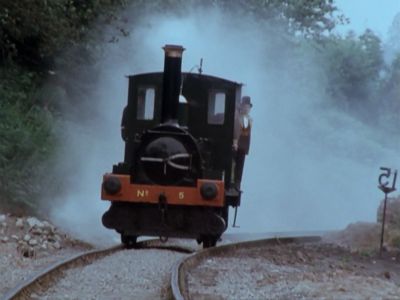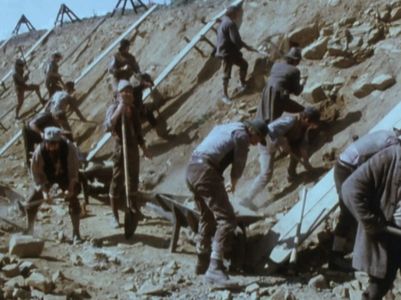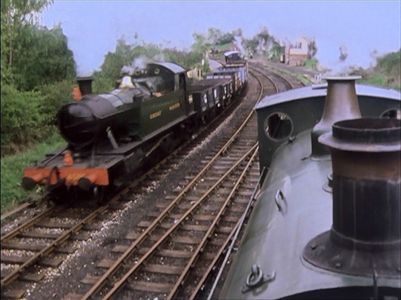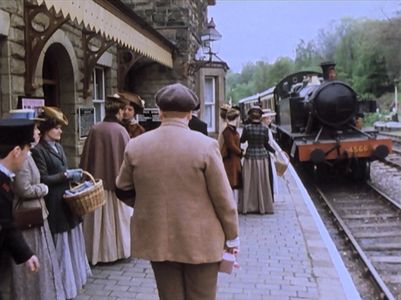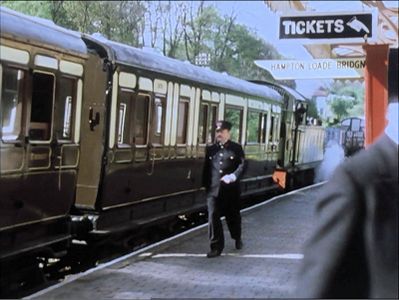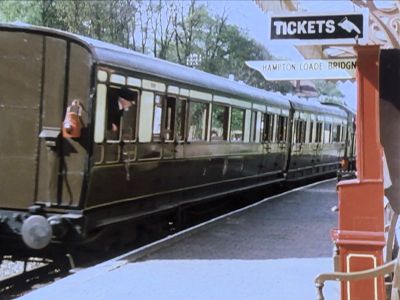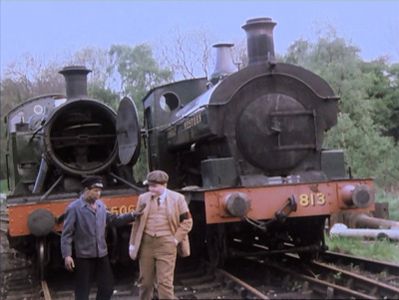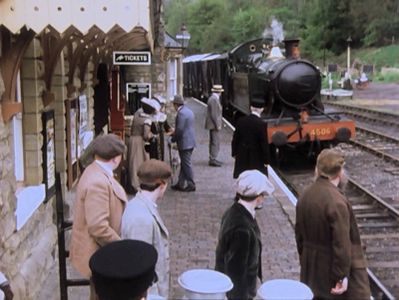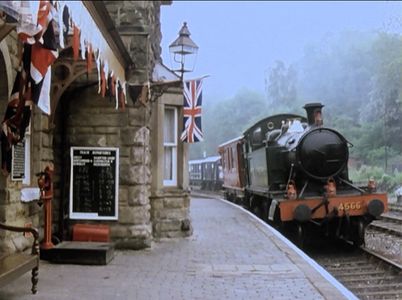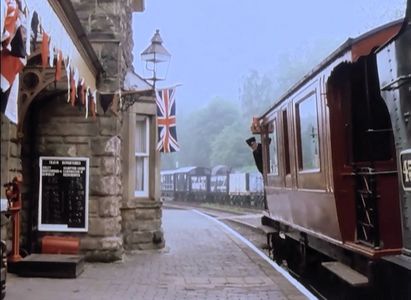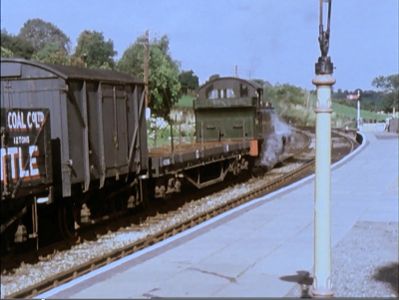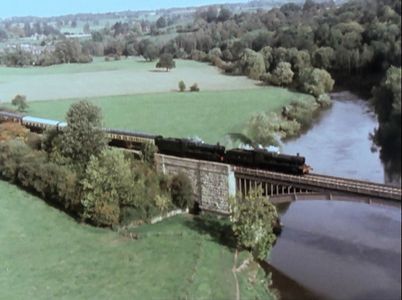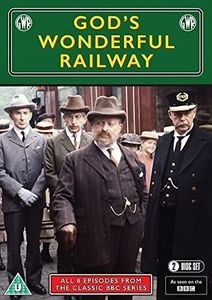God's Wonderful Railway
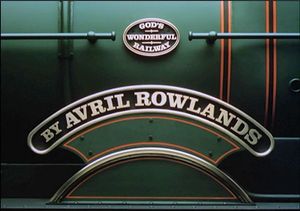
God's Wonderful Railway was a BBC children's drama series of 8 episodes, first broadcast in 1980. Written by Avril Rowlands, it was set specifically on the Severn Valley Railway and filmed almost entirely on location on the railway during 1979.[1] Rowlands was already associated with the SVR, having met her husband Christopher during filming of Carrie's War in November 1973.[2] Christopher Rowlands was also credited as the film editor for God's Wonderful Railway.
Television[edit | edit source]
The series was divided into three stories, set in different time periods in the history of the railway, through the eyes of a fictional railway family. In each story the main protagonist is a boy in his early to mid-teens, who then reappears as an adult in the following story.
The Permanent Way[edit | edit source]
The first story (two episodes) is set during the construction of the line, and its main character is Robbie Grant, a boy who has been brought to the valley because his father is working on the railway as a navvy. Although the Grant family was fictional, the story included characters such as Sir John Fowler and Henry Orlando Bridgeman who were involved in the building of the real Severn Valley Railway, while the plot line in which Robbie is severely injured by a fall of rock is notably similar to several actual accidents which took place during construction.
The Great Western Society Didcot's veteran Wantage Tramway locomotive No 5 "Shannon" was used for filming, being either propelled or hauled into shot as it was not in steam at the time. Its first appearance was as a contractors' locomotive while the line was being built, conveying Sir John Fowler and Henry Orlando Bridgman on the footplate to inspect the works.
-
Shannon as the contractors' locomotive
Shannon's second appearance was as the locomotive in charge of the opening train, where it seen crossing Victoria Bridge southbound both from the bank of the River Severn and from track level. Victoria Bridge had also featured in a scene shortly before the opening of the railway, although the many scenes involving the navvies digging a deep cutting were filmed elsewhere.
-
Navvies constructing a cutting
-
Shannon crossing Victoria Bridge (1)
-
Shannon crossing Victoria Bridge (2)
'The Permanent Way' included at least one small anachronism; the Arley distant signal is briefly visible on the approach to Victoria Bridge. Such signals were not installed until later in the nineteenth century.
Clear Ahead[edit | edit source]
The second story (three episodes) is set in 1906, during the Edwardian era, when the now-elderly Robbie is the signalman at Highley, and his grandson George is about to start work as a porter at the station. Most of the action in 'The Permanent Way' was filmed around Highley station. GWR Small Prairie 4566 served as a locomotive of that era, having been repainted with 'Great Western' on the tank sides for filming.[3] The locomotive appeared both with its own number and as classmate 4506. The "GWR carriages" seen were three Ex-Longmoor Saloons which were on loan to the SVR from the Army Trust, having previously being in service at the Longmoor Military Railway. All three were repainted in GWR colours for filming purposes with permission of the Army Trust. The carriages were:[4]
- Family Saloon, Army 3006 (originally SECR 177 and later SR 7913) built at Ashford in 1907
- Family Saloon, Army 3007 (originally LSWR 11 and later SR 7803) built at Eastleigh in 1910 (both used in the passenger trains)
- 6-wheel Saloon, Army 3005 built at Wolverton in 1910 and believed to have been used by LNWR CME George Whale (used in the 'royal train').
Scenes involving rolling stock are:
Part 1:
- 4566 with a goods train passing through Highley, with 813 in the yard.
-
4566 leaving Highley, passing 813
- 4556 in a brief lineside shot with two carriages.
- 4566 arriving at Highley at the head of a typical 'mixed' train with two carriages and Mink A 104621. The locomotive then runs round while 813 is again seen in the yard.
-
4566 arriving with a 'mixed' train
- 4566 arriving at Highley with two carriages.
- The young George Grant and Ted Jarvis with '4506' and 813 at Highley
-
George Grant and Ted Jarvis with '4506' and 813
- '4506' arriving at Highley with a goods train.
-
'4506' with a goods
- A closing shot of 4566 passing through Highley non-stop with the 'mixed'.
Part 2:
- 4566 arriving at Highley with a goods train, filmed from inside the signal box.
- 4566 arriving at Highley southbound with a passenger train.
- 4566 leaving Highley with a passenger train.
- 4566 leaving Highley with a passenger train.
- 4566 leaving Highley southbound with a goods train.
Part 3:
- A distant shot of the 'Royal Train' (4566 with the 6-wheel LNWR Directors' Saloon) crossing Victoria Bridge.
- The 'Royal Train' approaching Arley filmed from the road bridge.
- The 'Royal Train' arriving at Highley.
-
The Royal Train arriving at Highley
-
Ex-LNWR 6-wheel saloon
- The 'Royal Train' leaving Highley.
- 4566 arriving at Highley with two carriages.
- 4566 at Highley with two carriages (heard but not seen departing).
- 4566 arriving at Highley and departing southbound with a passenger train.
A brief clip of 4566 setting off from Arley was later reused by the BBC as a cutaway shot in the 1982 Doctor Who episode 'Black Orchid'.
Minor anachronisms:
- 4566 dates from 1924. It also portrays classmate 4506 which was one of the first batch of 4500 Class locomotives built in 1906, although small prairies did not appear on the Severn Valley Branch until around the 1920s.
- Mink A 104621 also dates from 1924, although the 'Iron Minks' began to be replaced by wooden bodied examples in the early 1900s.
- The departure finger post shows "Arley, N'Wood, Bewdley, Foley Park"; Northwood Halt did not open until 1935 (also no service would ever have terminated at Foley Park).
- The key token instruments in the signal box were not introduced by the GWR until 1914 and not on the Severn Valley Branch until after the Second World War. "Electric Staff" equipment was still in use in 1906.
Fire on the Line[edit | edit source]
In the final story (three episodes), set in 1939, George is Station Master at Arley; his son Andy has to deal with an evacuee from Birmingham billeted with the family, and becomes suspicious that a spy is trying to destroy Borle Viaduct.
Scenes involving rolling stock are:
Part 1:
- A distant shot of a GWR pannier 5764 with three carriages crossing Victoria Bridge northbound, continuing into a scene with Andy and Ted Jarvis (now a driver) filmed on the footplate.
- 5764 drawing into Platform 2 at Arley where Andy leaves the footplate
-
5764 arriving at Arley
- 4566 with a goods train at Arley where Andy joins the footplate and the locomotive leaves, the action continues on the footplate ending with a shot of the train between stations.
-
4566 at Arley
- A scene with the same train involving some loose shunting at the north end of Arley station.
-
Loose shunting
- 7819 Hinton Manor with a 5-coach troop train leaving Arley southbound
- A brief night shot of LMS 5000 passing Arley southbound – Andy sees it from his bedroom window and later remarks that it was 'not one of ours'
- 7819 Hinton Manor with a 3-coach train leaving Arley southbound, also filmed from the lineside and continuing with a scene filmed on the footplate.
- The train passing the Elan Valley Aqueduct with soldiers on guard duty.
-
7819 passing the Elan Valley Aqueduct
Part 2:
- A scene in Bridgnorth yard where Andy helps Ted Jarvis cleaning 7819. 5764 and 6960 Raveningham Hall are also seen in the yard.
- Hinton Manor leaving Bridgnorth with a passenger train.
- A night shot of Hinton Manor arriving at Arley with an engineering train (following a bombing attack on Victoria Bridge)
Andy was also filmed at other locations on the Railway including Hay Bridge and Daniel's Mill
Part 3:
- 5764 leaving Arley southbound with a passenger service
- 7819 Hinton Manor crossing Oldbury Viaduct with a passenger service
- 7819 Hinton Manor and 6960 Raveningham Hall leaving Bewdley double heading a troop train
- The same train is seen at various locations (not in geographical sequence) including passing Crossing Cottage, descending Eardington Bank, passing Waterworks Crossing, arriving at Arley, crossing Victoria Bridge and passing Hampton Loade before Andy manages to halt the train as it approaches Borle Viaduct. The train then passes through Arley again as the episode ends.
-
7819 Hinton Manor and 6960 Raveningham Hall crossing Victoria Bridge
Second Series[edit | edit source]
A second series, consisting of a further two stories in five episodes, was scheduled for production in the spring of 1981. The scripts were completed in the summer of 1980 and were to have featured Highley, Hampton Loade and Bridgnorth in particular, together with many of the SVR's engines. The fourth story was set during the closure of the line with Andy, now an engine driver, driving the last train. The final story was set at the start of the SVR's preservation era. The scripts were accepted by the executive producer, however financial difficulties at the BBC led to a late decision to the second series being 'axed'[5].
Novelisations[edit | edit source]
Novelisations of the three stories were published in separate volumes:
- Permanent Way (shortened from the television series title)
- Clear Ahead
- Fire on the Line
DVD release[edit | edit source]
The writer Avril Rowlands held a launch event at Kidderminster on 19 November 2017 to mark the release of the series on DVD.[6] Excerpts from the series were featured in a film show at Kidderminster Railway Museum on 27 January 2018 presented by Avril and Chris Rowlands, who also gave a talk on the work involved in making the series.
In addition to the 8 episodes, the DVD also includes two 'special features' recorded at the time. "On location" is a 25 minute documentary on the making of the series, showing how some of the railway scenes in "Fire on the Line" were filmed and including interviews with various cast members as well as Avril Rowlands and Alun Rees. "Blue Peter" is a 12 minute feature from the long-running children's TV programme which was broadcast the week before God's Wonderful Railway was first aired. Presenter Simon Groom introduced the upcoming series and visited the Severn Valley Railway where he interviewed Alun Rees and travelled on the footplate of Raveningham Hall between Bridgnorth and Arley. His journey was intercut with clips from the series filmed at Highley and Arley.
-
DVD Cover
